Page 244 of 643
POWER SUNROOF — IF EQUIPPED
The power sunroof switch is located between the sun
visors on the overhead console.WARNING!
•Never leave children in a vehicle with the key in
the ignition switch. Occupants, particularly unat-
tended children, can become entrapped by the
power sunroof while operating the power sunroof
switch. Such entrapment may result in serious
injury or death.
•In a collision, there is greater risk of being thrown
from a vehicle with an open sunroof. You could
also be seriously injured or killed. Always fasten
your seat belt properly and make sure all passen-
gers are properly secured.
•Do not allow small children to operate the sun-
roof. Never allow your fingers, other body parts, or
any object, to project through the sunroof opening.
Injury may result.
Power Sunroof Switch
3
UNDERSTANDING THE FEATURES OF YOUR VEHICLE 241
Page 299 of 643

The light also will turn on when the parking brake is
applied with the ignition switch in the ON/RUN posi-
tion.
NOTE:This light shows only that the parking brake is
applied. It does not show the degree of brake application.
19. Seat Belt Reminder Light When the ignition switch is first turned to ON/
RUN, this light will turn on for four to eight
seconds as a bulb check. During the bulb check, if
the driver or front passenger’s seat belt is unbuckled, a
chime will sound. After the bulb check or when driving,
if the driver’s seat belt remains unbuckled, the Seat Belt
Reminder Light will illuminate and the chime will sound.
Refer to “Occupant Restraints” in “Things To Know
Before Starting Your Vehicle” for further information. 20. Temperature Gauge
The temperature gauge shows engine coolant tempera-
ture. Any reading within the normal range indicates that
the engine cooling system is operating satisfactorily.
The gauge pointer will likely indicate a higher tempera-
ture when driving in hot weather, up mountain grades,
or when towing a trailer. It should not be allowed to
exceed the upper limits of the normal operating range.
CAUTION!
Driving with a hot engine cooling system could
damage your vehicle. If the temperature gauge reads
“H” pull over and stop the vehicle. Idle the vehicle
with the air conditioner turned off until the pointer
drops back into the normal range. If the pointer
remains on the “H” and you hear continuous chimes,
turn the engine off immediately and call an autho-
rized dealership for service.
296 UNDERSTANDING YOUR INSTRUMENT PANEL
Page 422 of 643
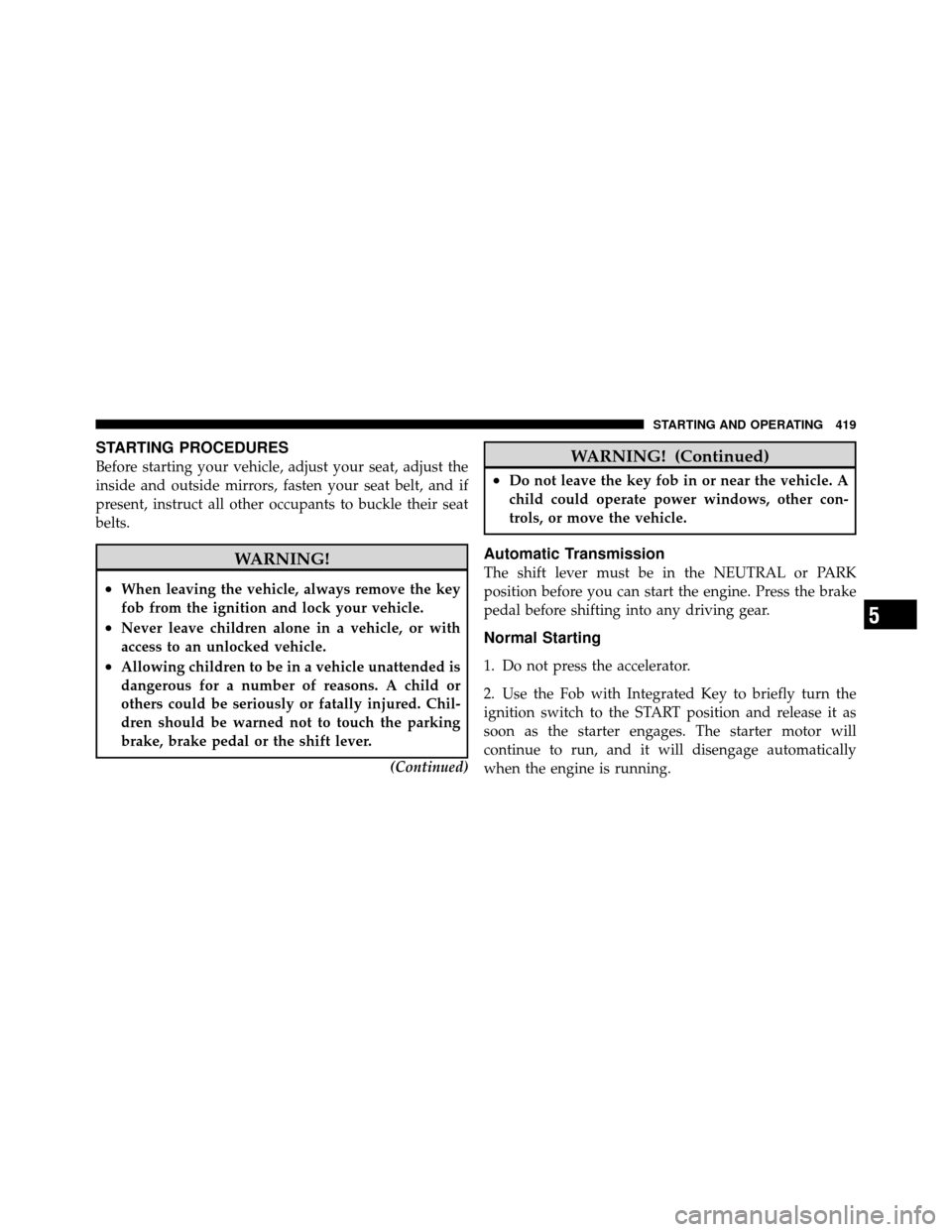
STARTING PROCEDURES
Before starting your vehicle, adjust your seat, adjust the
inside and outside mirrors, fasten your seat belt, and if
present, instruct all other occupants to buckle their seat
belts.
WARNING!
•When leaving the vehicle, always remove the key
fob from the ignition and lock your vehicle.
•Never leave children alone in a vehicle, or with
access to an unlocked vehicle.
•Allowing children to be in a vehicle unattended is
dangerous for a number of reasons. A child or
others could be seriously or fatally injured. Chil-
dren should be warned not to touch the parking
brake, brake pedal or the shift lever.(Continued)
WARNING! (Continued)
•Do not leave the key fob in or near the vehicle. A
child could operate power windows, other con-
trols, or move the vehicle.
Automatic Transmission
The shift lever must be in the NEUTRAL or PARK
position before you can start the engine. Press the brake
pedal before shifting into any driving gear.
Normal Starting
1. Do not press the accelerator.
2. Use the Fob with Integrated Key to briefly turn the
ignition switch to the START position and release it as
soon as the starter engages. The starter motor will
continue to run, and it will disengage automatically
when the engine is running.
5
STARTING AND OPERATING 419
Page 560 of 643
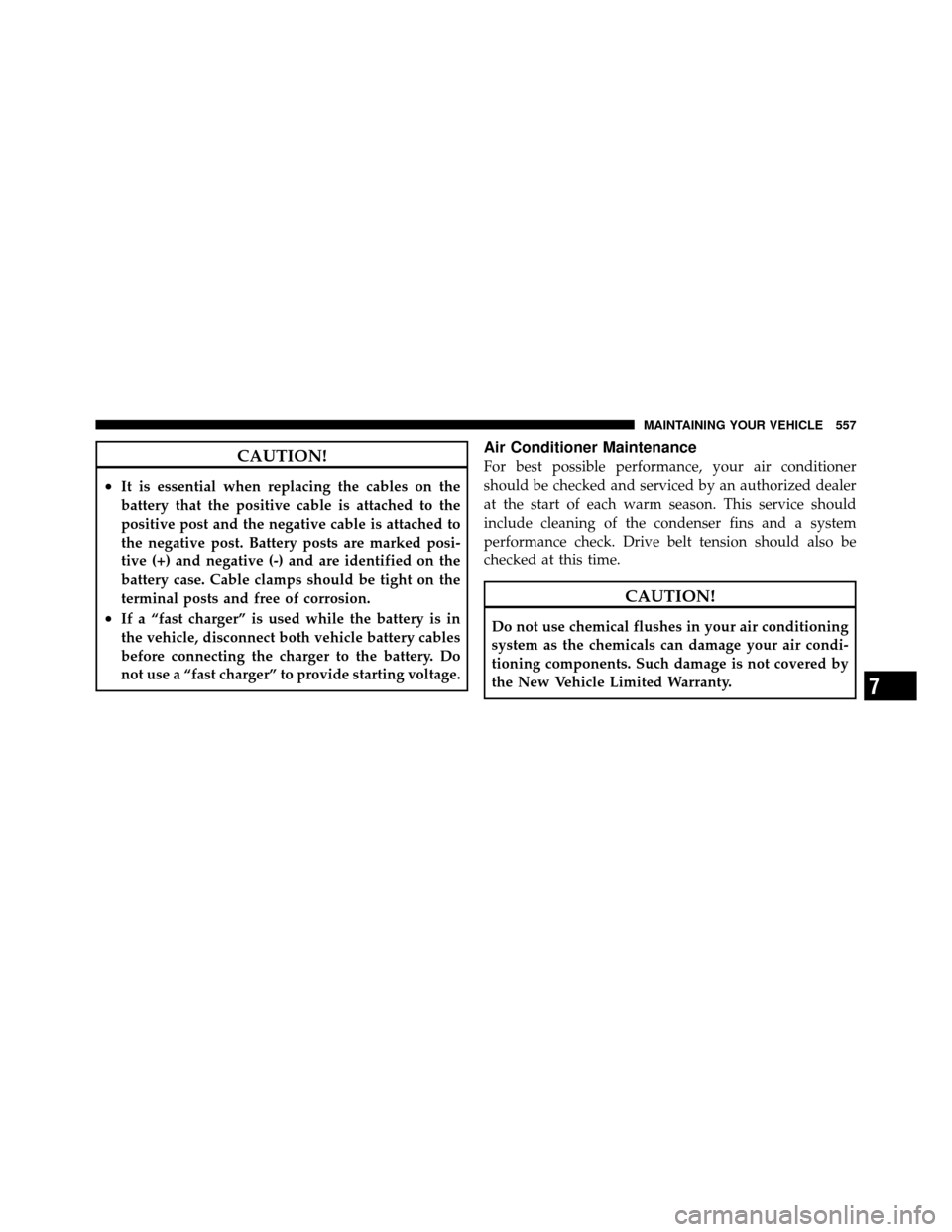
CAUTION!
•It is essential when replacing the cables on the
battery that the positive cable is attached to the
positive post and the negative cable is attached to
the negative post. Battery posts are marked posi-
tive (+) and negative (-) and are identified on the
battery case. Cable clamps should be tight on the
terminal posts and free of corrosion.
•If a “fast charger” is used while the battery is in
the vehicle, disconnect both vehicle battery cables
before connecting the charger to the battery. Do
not use a “fast charger” to provide starting voltage.
Air Conditioner Maintenance
For best possible performance, your air conditioner
should be checked and serviced by an authorized dealer
at the start of each warm season. This service should
include cleaning of the condenser fins and a system
performance check. Drive belt tension should also be
checked at this time.
CAUTION!
Do not use chemical flushes in your air conditioning
system as the chemicals can damage your air condi-
tioning components. Such damage is not covered by
the New Vehicle Limited Warranty.
7
MAINTAINING YOUR VEHICLE 557
Page 579 of 643
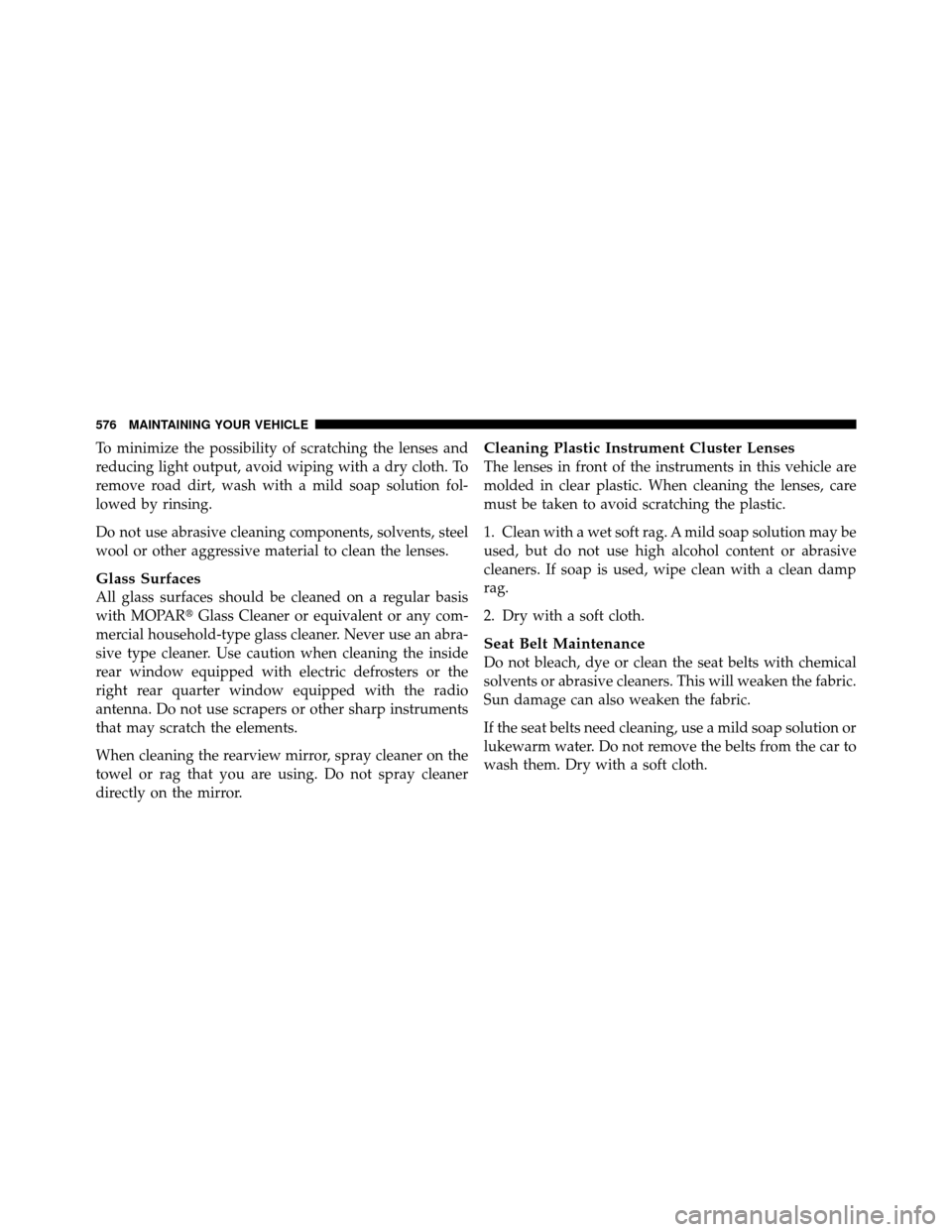
To minimize the possibility of scratching the lenses and
reducing light output, avoid wiping with a dry cloth. To
remove road dirt, wash with a mild soap solution fol-
lowed by rinsing.
Do not use abrasive cleaning components, solvents, steel
wool or other aggressive material to clean the lenses.
Glass Surfaces
All glass surfaces should be cleaned on a regular basis
with MOPAR�Glass Cleaner or equivalent or any com-
mercial household-type glass cleaner. Never use an abra-
sive type cleaner. Use caution when cleaning the inside
rear window equipped with electric defrosters or the
right rear quarter window equipped with the radio
antenna. Do not use scrapers or other sharp instruments
that may scratch the elements.
When cleaning the rearview mirror, spray cleaner on the
towel or rag that you are using. Do not spray cleaner
directly on the mirror.
Cleaning Plastic Instrument Cluster Lenses
The lenses in front of the instruments in this vehicle are
molded in clear plastic. When cleaning the lenses, care
must be taken to avoid scratching the plastic.
1. Clean with a wet soft rag. A mild soap solution may be
used, but do not use high alcohol content or abrasive
cleaners. If soap is used, wipe clean with a clean damp
rag.
2. Dry with a soft cloth.
Seat Belt Maintenance
Do not bleach, dye or clean the seat belts with chemical
solvents or abrasive cleaners. This will weaken the fabric.
Sun damage can also weaken the fabric.
If the seat belts need cleaning, use a mild soap solution or
lukewarm water. Do not remove the belts from the car to
wash them. Dry with a soft cloth.
576 MAINTAINING YOUR VEHICLE
Page 580 of 643
Replace the seat belts if they appear frayed or worn, or if
the buckles do not work properly.
Cleaning The Instrument Panel Cupholders
Removal
Pull the flexible liner from the cupholder drawer starting
at one edge to ease removal.
Cleaning
The liner is top shelf dishwasher safe, or you may follow
the cleaning procedure below.
Soak the liner in a mixture of medium hot tap water and
one teaspoon of mild liquid dish soap. Let soak forapproximately 30 minutes. After 30 minutes, pull the
liner from the water and dip it back into the water about
six times. This will loosen any remaining debris. Rinse
the liner thoroughly under warm running water. Shake
the excess water from the liner and dry the outer surfaces
with a clean soft cloth.
Installation
Place the liner into the cupholder drawer and press the
liner into place so that the retention tabs seat into the
corresponding openings in the drawer.
7
MAINTAINING YOUR VEHICLE 577
Page 624 of 643
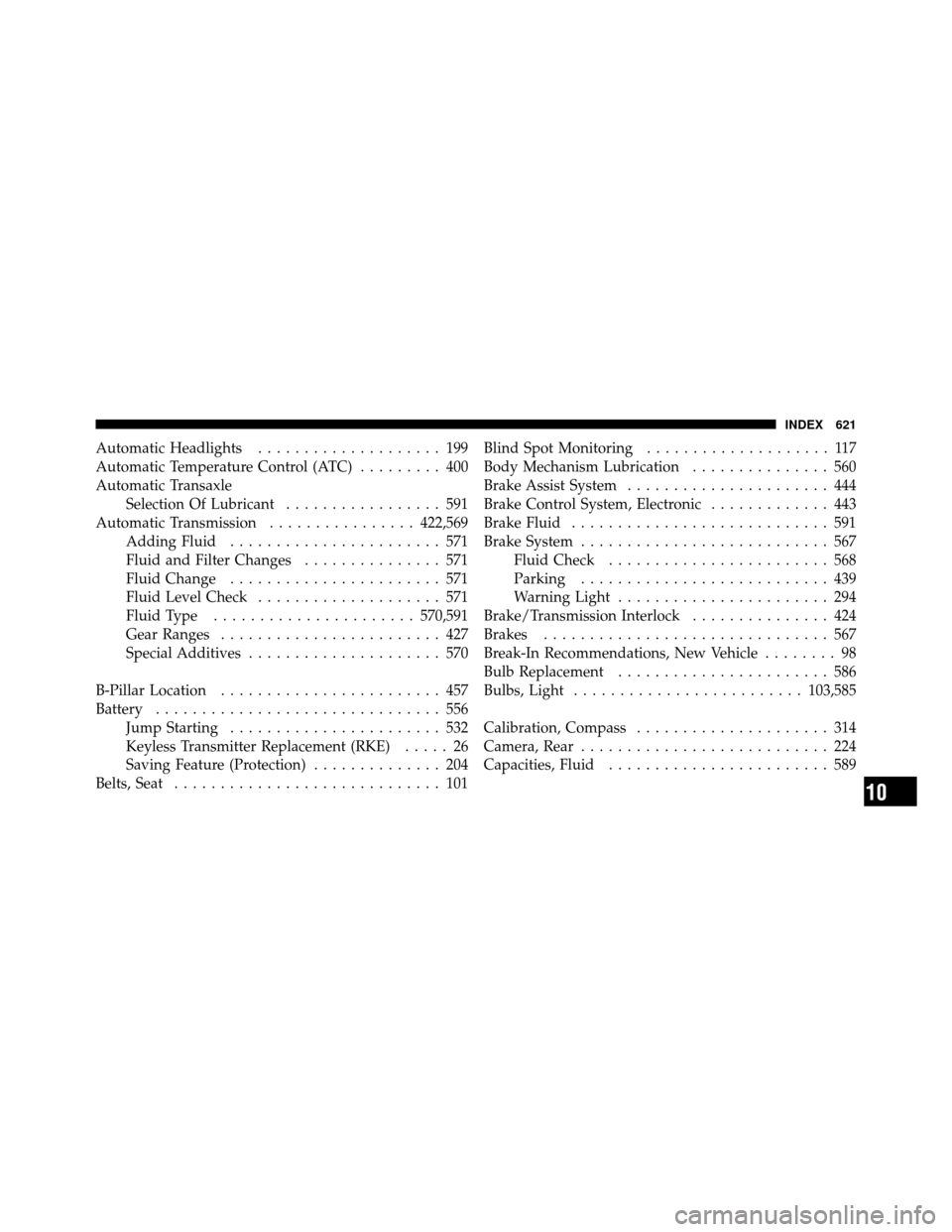
Automatic Headlights.................... 199
Automatic Temperature Control (ATC) ......... 400
Automatic Transaxle Selection Of Lubricant ................. 591
Automatic Transmission ................422,569
Adding Fluid ....................... 571
Fluid and Filter Changes ............... 571
Fluid Change ....................... 571
Fluid Level Check .................... 571
Fluid Type ...................... 570,591
Gear Ranges ........................ 427
Special Additives ..................... 570
B-Pillar Location ........................ 457
Battery ............................... 556
Jump Starting ....................... 532
Keyless Transmitter Replacement (RKE) ..... 26
Saving Feature (Protection) .............. 204
Belts, Seat ............................. 101 Blind Spot Monitoring
.................... 117
Body Mechanism Lubrication ............... 560
Brake Assist System ...................... 444
Brake Control System, Electronic ............. 443
Brake Fluid ............................ 591
Brake System ........................... 567
Fluid Check ........................ 568
Parking ........................... 439
Warning Light ....................... 294
Brake/Transmission Interlock ............... 424
Brakes ............................... 567
Break-In Recommendations, New Vehicle ........ 98
Bulb Replacement ....................... 586
Bulbs, Light ......................... 103,585
Calibration, Compass ..................... 314
Camera, Rear ........................... 224
Capacities, Fluid ........................ 589
10
INDEX 621
Page 628 of 643
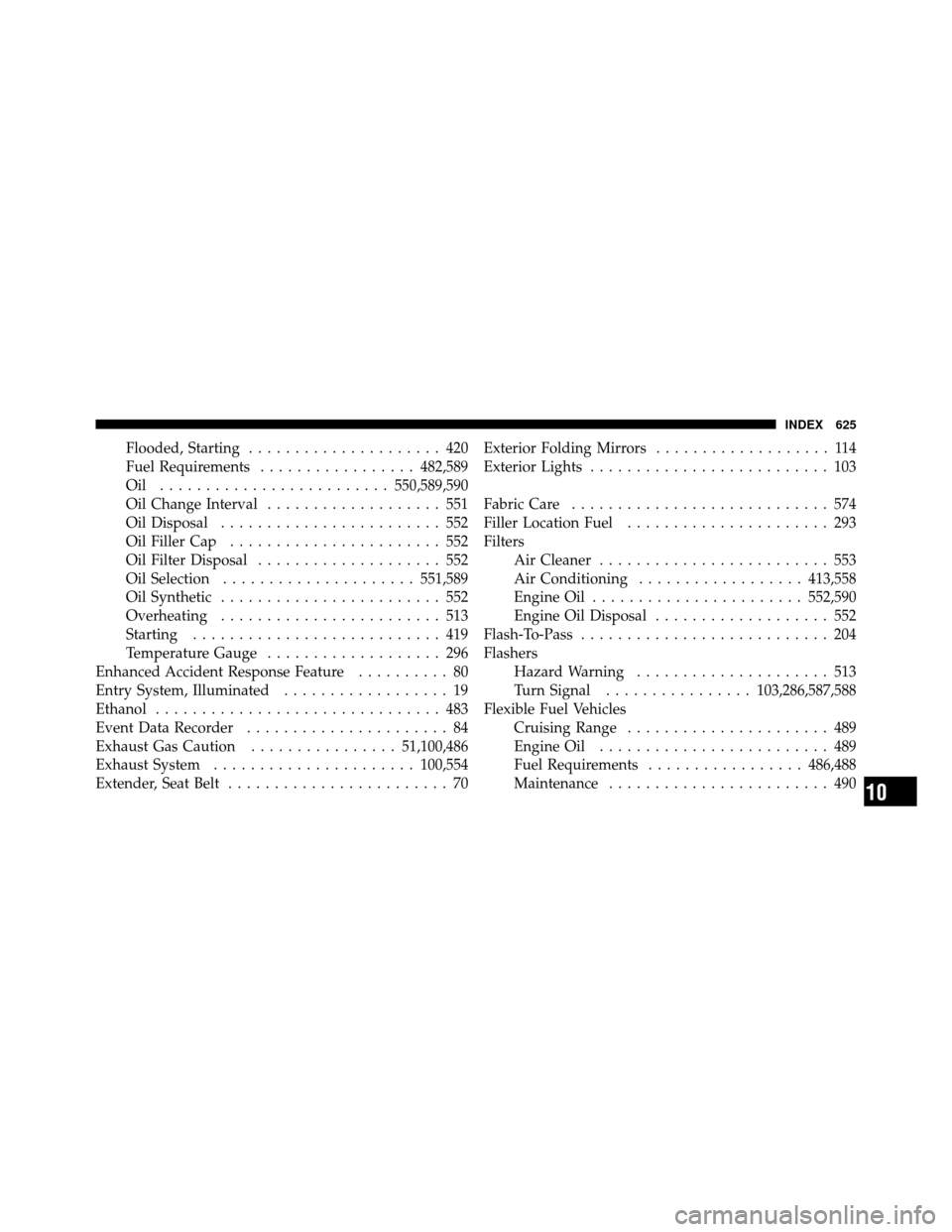
Flooded, Starting..................... 420
Fuel Requirements ................. 482,589
Oil ......................... 550,589,590
Oil Change Interval ................... 551
Oil Disposal ........................ 552
Oil Filler Cap ....................... 552
Oil Filter Disposal .................... 552
Oil Selection ..................... 551,589
Oil Synthetic ........................ 552
Overheating ........................ 513
Starting ........................... 419
Temperature Gauge ................... 296
Enhanced Accident Response Feature .......... 80
Entry System, Illuminated .................. 19
Ethanol ............................... 483
Event Data Recorder ...................... 84
Exhaust Gas Caution ................51,100,486
Exhaust System ...................... 100,554
Extender, Seat Belt ........................ 70 Exterior Folding Mirrors
................... 114
Exterior Lights .......................... 103
Fabric Care ............................ 574
Filler Location Fuel ...................... 293
Filters Air Cleaner ......................... 553
Air Conditioning .................. 413,558
Engine Oil ....................... 552,590
Engine Oil Disposal ................... 552
Flash-To-Pass ........................... 204
Flashers Hazard Warning ..................... 513
Turn Signal ................ 103,286,587,588
Flexible Fuel Vehicles Cruising Range ...................... 489
Engine Oil ......................... 489
Fuel Requirements ................. 486,488
Maintenance ........................ 490
10
INDEX 625